
Huawei Transmission Network hardware is one of the most professional and popular devices in the market. Without the transmission network, we will be hard to connect the Internet!
In this blog, I will introduce you the hot series of Huawei Transmission Network, including OTN and MSTP.
Hot Huawei MSTP
What is MSTP? MSTP (SDH-based multi-service transport platform) refers to the multi-service node that provides unified network management for access, processing, and transmission of services such as TDM, ATM, and Ethernet based on the SDH platform.
Huawei provide these popular MSTP platforms:
(1) Huawei OptiX OSN 500&550&580 MSTP
The OptiX OSN 500 is of a pure packet architecture, and supports a variety of service access modes. It completes Huawei’s optical transmission system, and sharpens the competitive edges of Huawei’s optical transmission products.
The OptiX OSN 550 supports various service networking topologies in the time division multiplexing (TDM) and packet domains, applicable to a wide range of scenarios.
The OptiX OSN 580 supports a variety of service network topologies in the TDM and packet domains, able to meet customers’ various service development demands.
Application Scenarios of OptiX OSN 500&550&580 MSTP
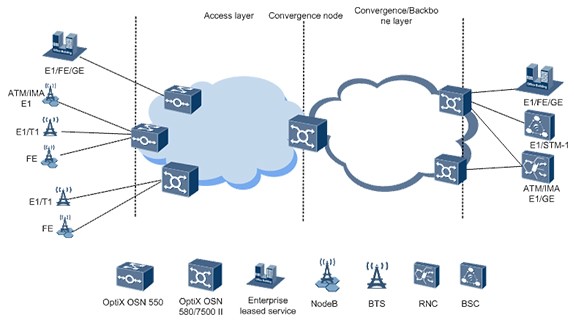
Learn more from the overview: Huawei OptiX OSN 500/550/580 Overview
(2) Huawei OptiX OSN 7500/7500II MSTP
The OptiX OSN 7500 intelligent optical switching system (the OptiX OSN 7500 for short) is the next-generation intelligent optical core switching (OCS) equipment and is developed by Huawei on the basis of the current situation and development trend of the metropolitan area network (MAN).The OptiX OSN 7500 is mainly used as a service scheduling node at the metropolitan backbone layer. That is, it functions as optical core switching equipment (OCS). As an intelligent optical transmission platform and core optical transmission system, the OptiX OSN 7500 is located at the metropolitan backbone layer to schedule and transmit services of different types and granularities.
The OptiX OSN 7500 II intelligent optical switching system (the OptiX OSN 7500 II for short) is the next-generation intelligent optical core switching (OCS) equipment and is developed by Huawei on the basis of the current situation and development trend of the metropolitan area network (MAN).The OptiX OSN 7500 II is mainly used as a service scheduling node at the backbone layer of the MAN. That is, it functions as optical core switching equipment (OCS). As an intelligent optical transmission platform and core optical transmission system, the OptiX OSN 7500 II is located at the metropolitan backbone layer to schedule and transmit services of different types and granularities. The OptiX OSN 7500 II is of a “universal switch” architecture. That is, the OptiX OSN 7500 II can be used in packet mode or in TDM mode. When used with the other equipment of Huawei, the OptiX OSN 7500 II supports various networking applications, such as the pure packet mode application, hybrid networking application (overlay networking of the packet mode and TDM mode), and pure TDM mode application. By using a proper networking solution, the data service and conventional SDH service can be processed in the optimal manner.
Application of the OptiX OSN 7500 in the transmission network
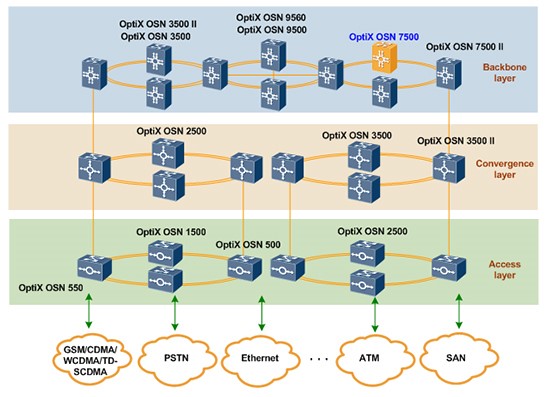
Application of the OptiX OSN 7500 II
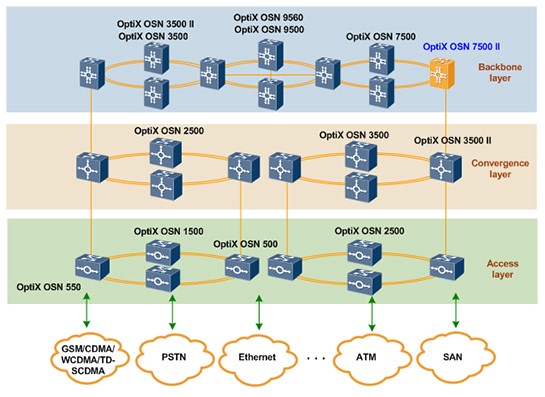
Learn more from the overview: Huawei OptiX OSN 7500/7500 II Overview
Hot Huawei OTN
What is OTN? An optical transport network (OTN), a type of network, refers to a transport network that implements transmission, multiplexing, routing, and monitoring of service signals in the optical domain, and guarantees performance indicators and survivability.
Huawei provides these popular OTN platforms.
(1) Huawei OptiX OSN 1800 OTN Platform
The Huawei OptiX OSN1800 is a series of box architecture Multi-Service Optical Transport Network (MS-OTN) transmission equipment that supports Time Division Multiplexing (TDM), packet, and Optical Transmission Network (OTN) services over a metro or campus optical network. This equipment enables multiple high-bandwidth services (from 2 Mbit/s to 100 Gbit/s) to be delivered at less cost. The OptiX OSN 1800 supports resilient, low-latency video transmission, real-time industrial automation applications, and server-based multimedia applications. It provides cost-effective transport solutions for power, medical, Storage Area Networks (SANs), data centers, and video surveillance.
Application Scenarios of OptiX OSN 1800
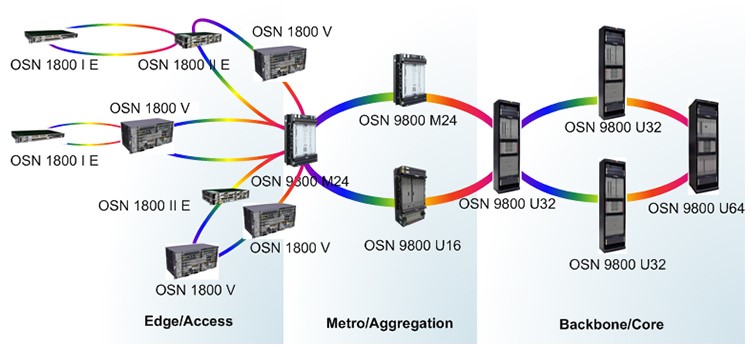
Learn more from the overview: Huawei OptiX OSN 1800 Overview
(2) Huawei OptiX OSN 8800&6800&3800 OTN Platform
The OptiX OSN 8800 Intelligent Optical Transport Platform (OptiX OSN 8800 for short) is a new generation of intelligent MS-OTN product. It is a future-proof product launched to address the IP-based metro network development trend. Using a new architecture, the product supports dynamic optical-layer grooming and flexible electrical-layer grooming. In addition, the product features high integration and reliability and supports multi-service transmission. The OptiX OSN 8800 is used for long haul backbone, area backbones, local networks, metropolitan convergence layers and metropolitan core layers. The OptiX OSN 8800 uses dense wavelength division multiplexing (DWDM) or coarse wavelength division multiplexing (CWDM) technologies to achieve transparent transmission with multiple services and large capacity.
The OptiX OSN 6800 Intelligent Optical Transport Platform (OptiX OSN 6800 for short) is referred to as Huawei next generation intelligent optical transport platform. The OptiX OSN 6800 is for area backbones, local networks, metropolitan convergence layers and metropolitan core layers. It may also work with other WDM, SDH/SONET equipment to offer a complete Metro WDM solution. The OptiX OSN 6800 supports 40 Gbit/s and 100 Gbit/s line rates and a 360G bit/s cross-connect capacity. It features power saving, and high reliability and maintainability.
The OptiX OSN 3800 Compact Intelligent Optical Transport Platform (OptiX OSN 3800 for short) is referred to as Huawei next generation intelligent optical transport platform. The OptiX OSN 3800 is for metropolitan convergence layers and metropolitan access layers. It may also work with other WDM, SDH/SONET equipment to offer a complete Metro WDM solution.
Application Scenarios of OptiX OSN 8800&6800&3800
Position of the OptiX OSN 3800 / 6800 in the network hierarchy
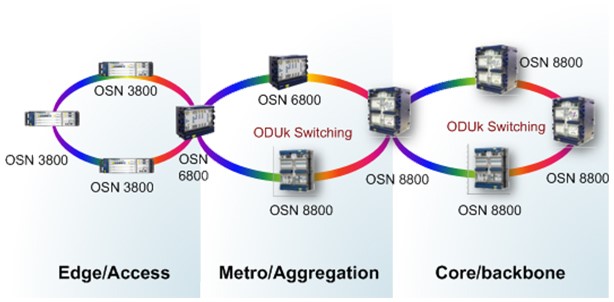
Typical OTN networking of OptiX OSN 8800
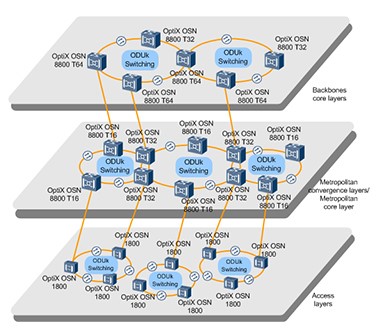
Typical OCS(optical core switching) networking of OptiX OSN 8800
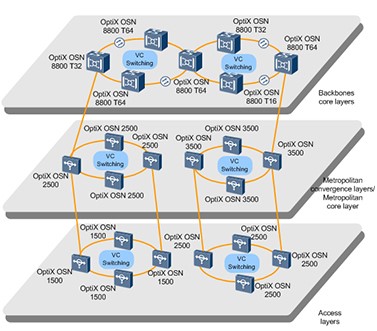
Typical MS-OTN networking of OptiX OSN 8800
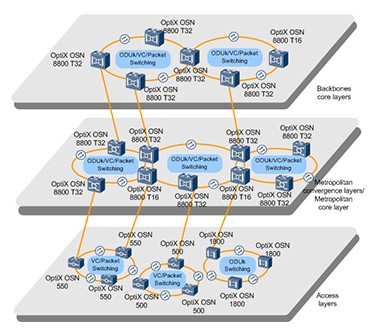
Learn more from the overview: Huawei OptiX OSN 8800/6800/3800 Overview
(3) Huawei OptiX OSN 9800 OTN Platform
Intended for 100G and beyond 100G optical networks, the OSN 9800 U64/U32/U16 subrack is a next-generation large-capacity OTN product that integrates ASON, OTN, and packet functions. It is applicable to various networks, including super-backbone, backbone, and metro networks.
OSN 9800 M24 is a next-generation ultra-large capacity, high integration, and optoelectronic OTN/WDM product developed based on new software and hardware platforms. It is applicable to backbone and metro networks.
OSN 9800 universal platform subrack mainly works with the OSN 9800 U64/U32/U16/M24, which is applied at the electrical layer in WDM and OTN system. Empowered with these features, OSN 9800 universal platform subrack enables end-to-end OTN/WDM backbone transport solutions and implements multi-service, large-capacity, and fully transport transmission.
The OSN 9800 P32 subrack is an ultra-large capacity all-optical cross-connect product. It is mainly used at the backbone core layer and metro aggregation layer. It works with the OSN 9800 / 1800 to build a complete E2E WDM/OTN backbone transmission solution, achieving transparent and ultra-large capacity transmission.
Role of the OptiX OSN 9800 in a network-wide solution
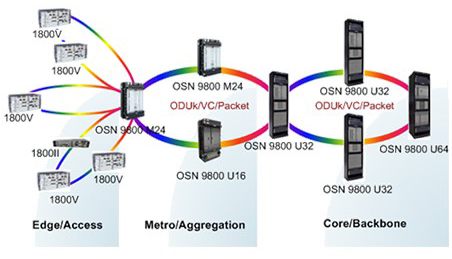
Hybrid networking with OptiX OSN 9800 and OptiX OSN 8800 / 6800
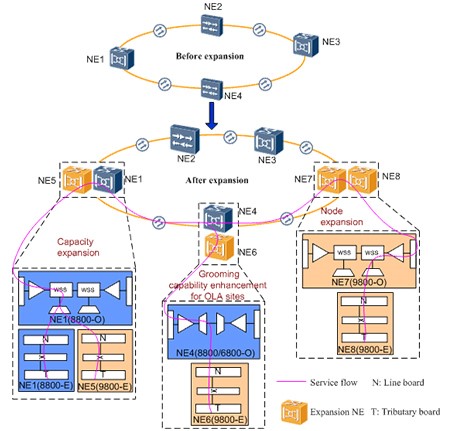
Learn more from the overview: Huawei OptiX OSN 9800 Overview
Have you learnt more about Huawei Transmission Network now? If you’re interested, you can view these related topics:
What is the Transmission Network? 7 Concepts You need to know!
What is the Difference of CWDM, DWDM and CCWDM?





